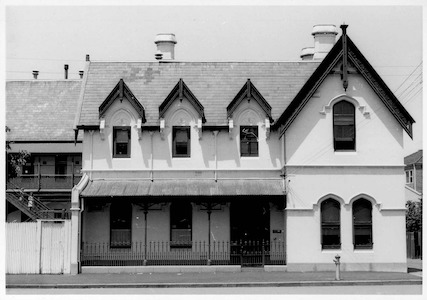The Find & Connect Support Services were established to provide assistance to people who were in care between 1920 and 1990. The Find & Connect Web Resource not only provides information on homes that operated in that time, but also provides important historical context to the welfare system in Australia.
New dedicated pages to the Victorian Neglected Children’s Aid Society Receiving Home, (later the Victorian Children’s Aid Society) bring a part of that history to life.
Established by “Child Rescuer” Selina Sutherland on La Trobe st, the Victorian Neglected Children’s Aid Society Receiving Home temporarily housed children who were then placed with suitable families in the country. Unusual for the time, the Home was “careful not to break family ties and keep respectable parents in touch”. Many of the children placed by the Receiving Home were there due to family poverty, who Sutherland described as the “unfortunate but decent and respectable poor”, with the hope they could return home in future.
From 1897 the Home began to take in children that were apprehended by the police at night, who previously would have been out in the cells with adults, leading to the Chief Commissioner organising for its rent to be paid by the Victorian Government in 1904.
“Aged and decrepit women” were also provided temporary accommodation, as well as women with infants. In 1906, the Home was gazetted as a State School, with the Department of Education taking over teaching the children.
The Home grew to include five properties until a very public rift that had been covered by the papers all over Australia erupted in 1908. Sutherland was dismissed by the committee and refused to leave the premises in Parkville. Whilst a compromise was reported shortly after, Sutherland barricaded herself into the home, denied staff entry and had a dining room nailed shut with a committee member inside. She, along with supporter Miss Coltman, who was “prepared to stand a siege for six months” also managed to eject a man from her original property in La Trobe st.
Later in the day, however, the instalment of a man named Derry on behalf of the committee caused a scene at Latrobe street which called for the intervention of the police. The night passed with both sides in an attitude of armed neutrality, but on Sunday morning Miss Sutherland, who had been advised of the occurrences, went down to Latrobe street and restarted the campaign with great vigour. She ordered Deny out of the place, but he refused to go. Miss Sutherland then went around to the Russell Street Police Station to seek advice. The police thought that their interference would only aggravate matters, and declined to advise Miss Sutherland. She then left the station, but returned in half an hour. “I have done it,” she announced “Done what?” asked Constable McAuley. “Chucked him out,” replied Miss Sutherland triumphantly, as she left the station.
Observer (Adelaide, SA : 1905 – 1931)
These incidents, and charges brought by the committee against her of intoxication and violence, which were dismissed, did not dent her reputation. Within a couple of weeks of moving back to the original La Trobe st property, Sutherland established the Sutherland Homes for Children. She continued her work for another year until her death in 1909, however her legacy lived on. Sutherland Child Youth & Family Services, as it became known in 1991, finally amalgamated with Berry Street in 1994.
The Victorian Neglected Children’s Aid Society continued until 1920, when it became the The Victorian Children’s Aid Society Home. Former resident, Warren Smith shared his memories of living in the home with Find & Connect, including a WW2 evacuation from Parkville to a farm in Trawalla:
One day some cars came into the home and we were divided into groups of 5 or 6 and then told to get into cars. In we got, me sitting next to a lady driver and away we went. This was the first time I had been in a car and I thought it was great.
Eventually we turned off the main road into a white gravelled country road with big pine trees growing on either side. We went along this road for a fair way and when we reached the end of this road we came to a huge open area of open country, a vegetable garden and orchard on the left with a running creek below it.
Further down the road was a timber bridge going across the creek where the farm workers lived, there was a bake house, cook house, horse stables, blacksmith shop, pig stys and living quarters for the men. The manager’s place was across the creek from the garden.
On the right hand side up a slight rise was a big tin building (later discovered as being shearing sheds) and about 200 yards was the shearers quarters, this was where we were going to live, after living at Parkville’s confined space this looked marvellous . The farm had supplied a milking cow for the home’s use and one of the big girls was to become the milk maid.
This girl on occasions took me with her while she milked, sometime telling me to open my mouth then she would squirt milk straight from the cow towards my mouth. Although I ended up with milk all over me I did manage to get a good drink. It was wonderful and I have never forgotten how pleasurable little things in life can be.
Warren Smith 2013







Brian Cherrie
June 28, 2023 8:28 pmThis is wonderful to read the early history of another children’s home and the various staff that ran these places, bearing in mind what the history of what unfolded in The Royal Commission into these places.